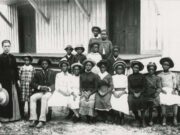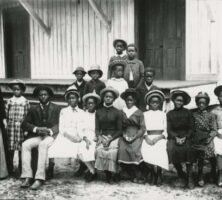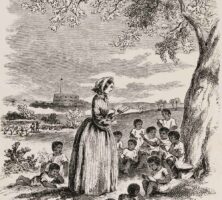From the first days of their freedom, formerly enslaved Georgians demanded formal education. Legislation passed in 1829 had made it a crime to teach enslaved laborers to read, and, further, white attitudes discouraged literacy within Georgia’s small free Black community. Yet when schools for freedpeople opened in early 1865, they were crowded to overflowing. Within a year of Black freedom, at least 8,000 formerly enslaved African Americans were attending schools in Georgia; eight years later, Black schools struggled to contain nearly 20,000 students.
Organization and Support
While northern private benevolence and the federal government deserve credit for aiding Black education in Georgia during Reconstruction, the primary impetus and sustaining force came from the state’s African Americans. The first postwar schools were former clandestine schools, operating openly by January 1865. Literate Black men and women opened new, self-sustaining schools. Northern freedmen’s aid organizations began establishing schools in mid-1865. Of the nearly fifty aid societies working in freedmen’s education in the 1860s, only seven were active in Georgia. These benevolent organizations raised funds, recruited teachers, and attempted to keep the future of the freedpeople before the northern public.
Meanwhile, Congress created the Bureau of Refugees, Freedmen, and Abandoned Lands, popularly known as the Freedmen’s Bureau, in March 1865. Though it did not hire teachers or operate schools itself, the bureau assisted the aid societies in meeting the burgeoning African American demand for education. It rented buildings for schoolrooms, provided books and transportation for teachers, superintended the schools, and offered military protection for students and teachers against the opponents of Black literacy.
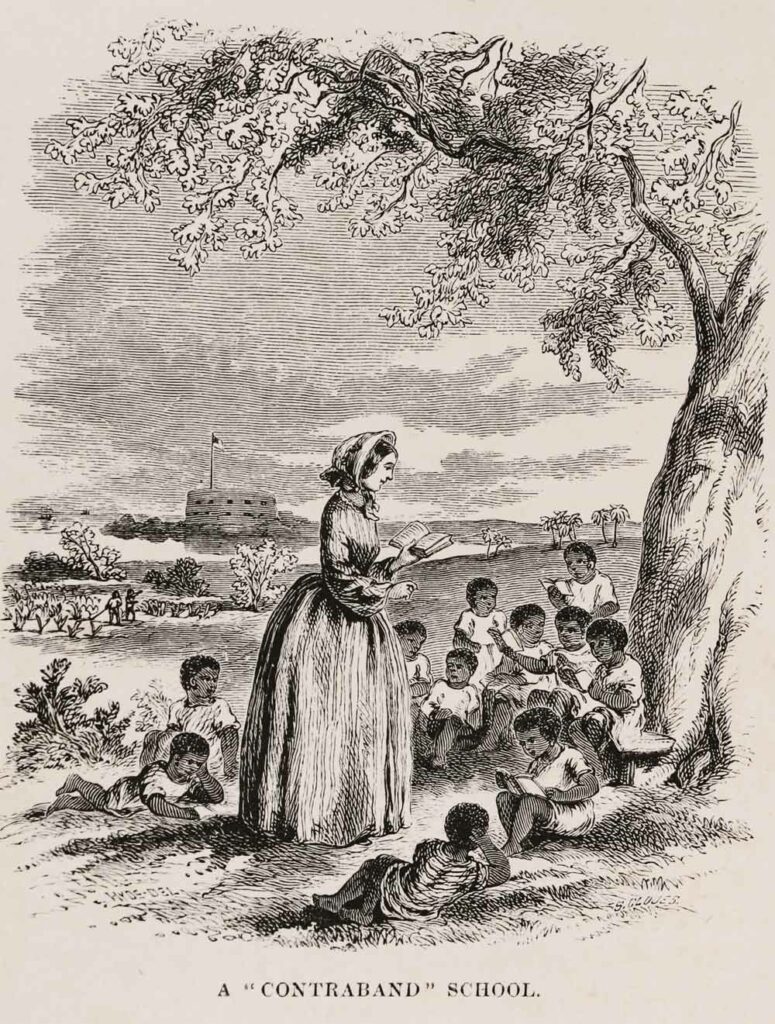
Image from American Antiquarian Society
Even where the bureau and northern aid did reach into Georgia, however, the freedmen themselves provided a substantial amount of support for the schools. They paid monthly tuition fees, raised funds for teachers’ room and board, purchased lots for schoolhouses, and donated material and labor to build them. They also created and supported schools that were independent of northern efforts. Until 1870, while sustaining their own schools, the freedmen—nearly half of the state’s population—were also required to pay school taxes for privileges from which they were excluded.
Adult freedmen sought the benefits of literacy for themselves as avidly as they sought schools for their children. In winter and in the slack times between planting and harvesting, fathers and mothers recited beside their children in freedmen’s schools. To meet the demand for education from adults who could not attend regular classes, the teachers organized night schools and Sabbath-day schools. Throughout Reconstruction, teachers reported that adults often constituted one-third of their students. Adult students were also served by formal secondary and higher education institutions, ranging from normal schools for teacher training in Macon, Columbus, Savannah, and elsewhere, preparatory schools attached to colleges, and the colleges themselves: Atlanta University, Clark College (later Clark Atlanta University), and the Augusta Institute (later Morehouse College).
Teachers
Native Georgians, Black and white, along with northern teachers, shouldered the task of teaching in the freedmen’s schools. Of the nearly 600 teachers in Georgia’s freedmen’s schools during Reconstruction, more than one-fifth were native Georgians, including nearly fifty white Georgians. A quarter of the teachers were African Americans. More than half of the Black teachers were Georgians, while other Black teachers hailed from the seaboard South, along with Pennsylvania, New Jersey, New York, Massachusetts, and Ohio. Although contemporary teachers seldom had completed high school, many of the northern freedmen’s teachers had graduated from post-secondary institutions, including Dartmouth College in New Hampshire, Yale University in Connecticut, Oberlin College in Ohio, and Mount Holyoke College in Massachusetts. The Black teachers had attended such colleges as Oberlin, Wilberforce University in Ohio, and Lincoln University in Pennsylvania.
The State and Black Education
Before the Civil War (1861-65), Georgia had no system of public education. Its school tax assisted poor white children with tuition at private schools. In 1870 the state made its first effort to create public schools and found that, in the Black community at least, the rudiments of such a system were already in place. Reconstruction-era legislation required segregated schools and allowed discrimination in the distribution of school funds to white and Black schools.
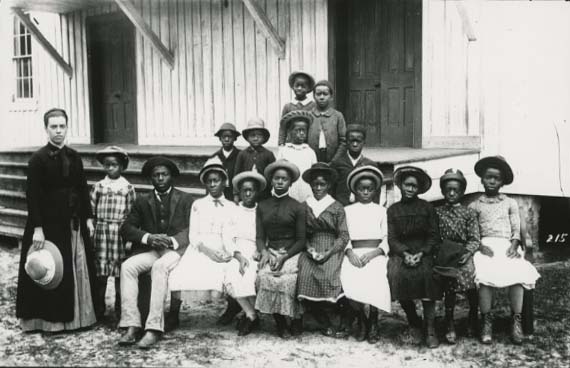
Courtesy of Hargrett Rare Book and Manuscript Library, University of Georgia Libraries.
Northern aid to freedmen’s education declined just as Georgia began to develop a dual system of education. The Freedmen’s Bureau closed its offices in 1870. The aid societies retrenched in that same year. They concentrated their efforts in Georgia’s largest cities and shifted their attention to teacher education, convinced that the best means of assuring a future for southern Black education was through the preparation of teachers for Black schools.
From 1870 until well into the twentieth century, white Georgians sought to limit public funding for Black education. Local districts refused to support public secondary education for African American students. Teachers in Black schools received lower salaries than those in white schools, regardless of the teachers’ race, and construction and maintenance of Black schools were neglected. The state would not provide public higher education to its former bondsmen until it founded Georgia State Industrial College (later Savannah State University) in 1891.
By the end of Reconstruction, the freedpeople of Georgia had built the foundations of a system of universal schooling. Native and northern teachers had taught thousands of formerly enslaved African Americans to read and write. Three colleges kept alive the promise of higher education. In the final analysis, however, the freedpeople were too poor, and the assistance from the federal government and northern agencies far too paltry, to have much effect. It is unlikely that more than 10 percent of the state’s African American population could find a seat in a schoolhouse during Reconstruction.


